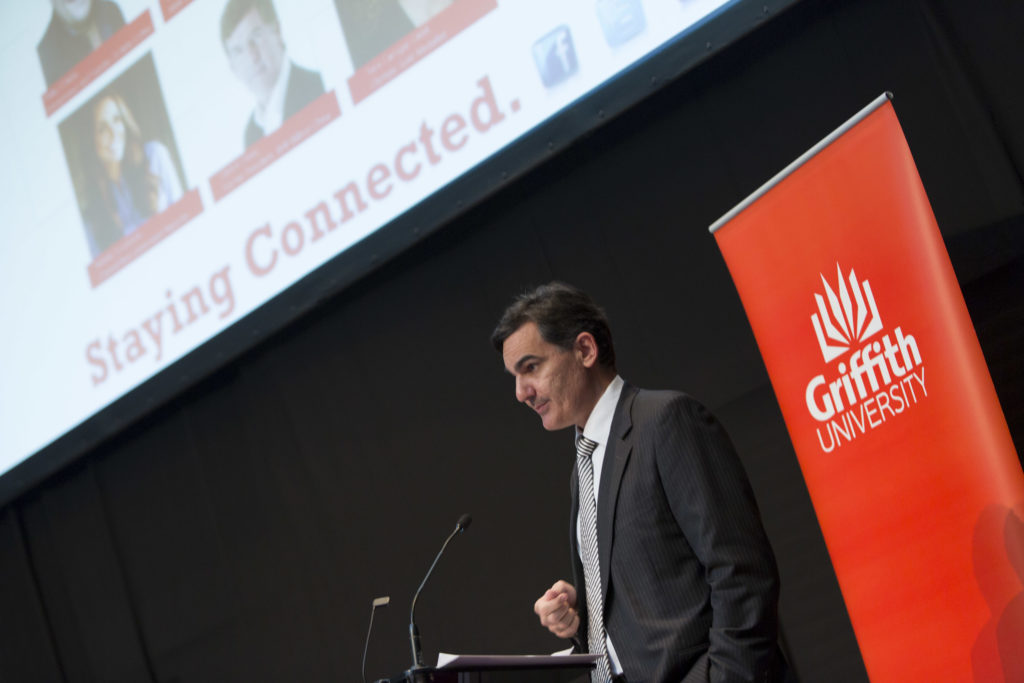This is section 2 of a series on the topic of ‘deriving impact from universities’ in the 21st century, authored by Nicholas Mathiou, Director of Griffith Enterprise.

“When winds and waves a mutual contest wage,
These foaming anger, those impelling rage;
Thy blissful light can cheer the dismal gloom,
And foster hopes beyond a wat’ry doom.”
– John William Smith, “The Lighthouse”, Terrors of Imagination, and Other Poems, 1814
Section 2. The ‘North Stars’
Introduction
Meeting the challenges that universities face in the dynamic environments of today commences with determining direction. Finding our way can be difficult at the best of times, but given the rapid pace of change in the world right now, it can seem a little like being cut adrift in an ocean storm.
Clearly, universities need to mobilise their resources in different ways in order to manage, but to what end and in which direction? How can universities reset their bearings to remain relevant to the issues of today? An appropriate way to start answering these questions is by examining major trends and demographic shifts and the associated roles that universities play. This is where opportunity lies for universities.
A cursory examination of major trends and demographic shifts in this context reveals, firstly, the changing natures of workforces and, secondly, the sharp rise in entrepreneurship on the back of digital advancement. Thirdly, it also points us to a litany of enduring and emerging societal needs. With an assured focus on each of these three ‘North Stars’, universities can navigate our changing times, as outlined below.
Changing natures of workforces
Economies, industries, and organisations are transforming, driven by trade liberalisation and advancing technologies, and this transformation is affecting the natures of workforces like never before. Many current jobs will no longer be prevalent by 2030, given – among other things – the rise of automation and artificial intelligence. Many new jobs, some yet to be created and defined, will arise because of emerging technology platforms. The enduring impact of a global pandemic on world economies is likely only to accelerate this process.
A globally accessible labour force like none ever before now exists. Employers and workers can easily connect, transact and collaborate across geographies. There is a world of easily accessed and willingly deployed people who are trained, educated and talented. There is also a massive trend towards ‘work-on-demand’ – the ‘Gig Economy’. Teams of talented people are now able to seamlessly come together to work on a project. Highly skilled people now pursue multiple careers across their working lives.
As a result, the requirements of employers and employees are changing rapidly and it is beholden on universities to ensure their offerings to students are evolving in turn. Only in this way can universities continually provide students with the additional and updated skill-sets required to function in our rapidly evolving world.
In this climate of change, the so-called ‘soft skills’ – e.g. team work, client engagement, project management, capacity to learn and synthesise solutions from diverse information sources, negotiation, persuasion, creativity – are a more important objective for education and training. Experiential-based learning is required, therefore, where students are immersed in the acquisition and application of existing and new knowledge to solve problems.
The ability of universities to meet demand and provide evidence-based pedagogy and experiential-based learning environments is clearly critical, especially in the provision of both knowledge and skills development. This can be a major differentiating factor for universities, one that alternative providers may find difficult to match.
In summary, a constant focus on this ‘North Star’, on equipping graduates with the skillsets needed in new workforces will serve universities well in navigating the choppy waters of change.
The rise of innovation and entrepreneurship
The digital revolution has democratised knowledge, empowered consumers and spawned scores of new organisations. Access to customers and markets, products and services, labour and capital is no longer in the hands of the few, but is now available to us all. Major barriers to entrepreneurship are gone and businesses can now reach – quickly and affordably – virtually anyone, anywhere, anytime to deliver anything.
All organisations realise they need to innovate – new markets, new products and services, new business models. Larger established organisations under competitive pressures are demanding employees capable of creating better businesses within their confines (now labelled as ‘intrapreneurship’, but more commonly known as innovation).
We are witnessing a staggering shift towards entrepreneurship over employment and along with this a heightened demand for innovation and entrepreneurial skill-sets. This means the acquisition of knowledge and skills associated with innovation and entrepreneurialism is becoming a more important objective for education and training.
Just as universities are charged with keeping a watchful eye on the skills and knowledge demanded by employers and changed workforces, so too must they maintain a focus on the skills required by graduates to be successful and impactful in innovation and entrepreneurship.
Here too the ability of universities to provide evidence-based pedagogy and experiential-based learning environments to address this major shift (and a ‘North Star’) is therefore crucial.
Addressing societal needs
Many of the world’s challenges have yet to be resolved, and the needs are many. These range from the sustainable utilisation of resources to mitigate effects on our environment to the provision of sustainable health services for an ageing population to ensuring the wellbeing of impoverished people is addressed.[1]
There is now global recognition that multi-disciplinary, multi-party approaches are required to find complex solutions to such major societal issues. Governments alone cannot address the issues and are increasingly taking a collaborative role as designer and commissioner of services to address societal issues. But governments face fiscal constraints intensified by a combination of high debt levels, depleted revenues, rising unemployment, stalling growth and increasing demand for public interventions and related expenditure. An accelerating demand for social and environmental funding is outstripping broader economic growth.
Governments are, therefore, actively seeking sustainable service-provision and funding models. Capital markets are responding, and innovative financial structures to support the broad scale delivery of interventions are emerging. Pay-for-outcomes financial structures (e.g. social impact bonds) are emerging which require the service providers to carry the risk of delivering a social outcome, but reward them for successfully doing so.
Universities continue to have immense capabilities across many different disciplines and have a collaborative role to play here. They can (and do) play important roles in articulating the nature of problems, conceptualising new or improved models, developing policy, crafting appropriate programs and interventions, piloting models, programs and interventions, educating workforces that can address the societal needs and evaluating achievements of desired outcomes. Universities inform and provide the independent, evidence-based solutions that address and resolve immense challenges to society. By driving new knowledge, university research remains critical to success.
In the current climate of societal needs, it is clear that partnerships that facilitate the wide-scale delivery of evidence-based programs, coupled with sustainable outcomes-based funding models are required. By maintaining its gaze on this third ‘North Star’ – that of societal needs – universities can mobilise resources to manage a pathway through the environments of change.
Setting direction
The ‘North stars’ discussed above are three constants for universities regardless of the changing environments around us. By identifying major trends, demographic shifts and societal needs, universities continue to pinpoint the associated roles which keep them integral to society. These ‘North Stars’ can and must be utilised to set direction; this is fundamental to success.
Continually considering the following three questions can help universities set direction:
- Question 1: Whom do we serve?
- Question 2: What is our ambition?
- Question 3: What is our value?
Clearly, universities exist for the betterment of society. Fundamentally and ultimately, universities serve the public by identifying and responding to global challenges and significant societal needs. Universities’ ambitions (and arguably obligations) must be to address these challenges. The value they bring to society by doing so is profound.
However, whilst setting direction is necessary, it is insufficient for success. Universities must galvanise action toward the achievement of the direction. Establishing a strong sense of ‘purpose’ across the entire organisation can assist, and this can be crafted by understanding how universities materialise benefits for our world. This takes us to section 3 and a consideration of universities’ ‘spheres of impact’ which will be published next week.
Read the previous article from this series.

ABOUT THE AUTHOR: Nicholas Mathiou is Director of Griffith Enterprise, the innovation and enterprise office of Griffith University. He has extensive commercial experience, having established and grown innovation-based businesses and organisations. He is driven by an ambition to see great social dividends emerge through university-based innovation. He has a deep understanding of the unique challenges involved in advancing innovations within complex organisations and in dynamic environments.
[1] The United Nations has established 17 sustainable development goals as a blueprint to achieve a better and more sustainable future for all. Not surprisingly, this is a great place to start to determine how your university may contribute.
Introduction image credit: photo by Aron Visuals on Unsplash


